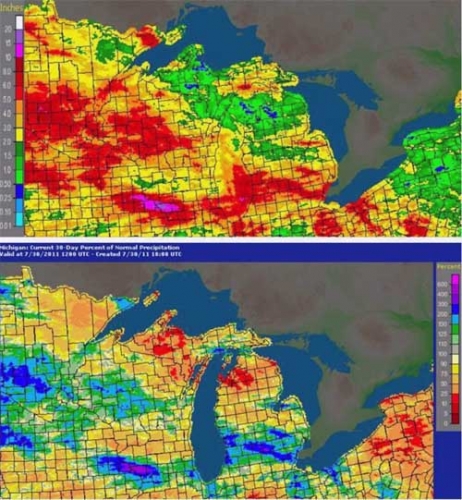Frost and freezing temperatures possible later this week
Farmers and gardeners are urged to watch forecasts this week and be prepared to use frost protection when possible.
Major weather changes are in store across the Great Lakes region this week with the expected formation of deep upper air trough across eastern Canada that will allow the southward movement of a cold, Canadian-origin air mass into the lower 48 states. One cold front will pass northwest to southeast across the state Tuesday (September 13), bringing the threat of showers and thundershowers to northern sections of the state.
A second, stronger cold front, marking the leading edge of the Canadian air mass, will then move through the region on Wednesday. While the passage of the second front will be dry across most of the state, the movement of cold air behind the front across relatively warm waters of the Great Lakes will lead to lake effect clouds and rain showers over much of the state Wednesday.
Look for temperatures to fall from highs in the 60s and 70s early Tuesday, back to the upper 50s north to mid-60s south Wednesday through Saturday. As the center of the high pressure air mass approaches, look for fair to partly sunny conditions during the day Thursday and Friday. Clear and relatively calm conditions are expected overnight Friday and Saturday, potentially leading to frost and freezing temperatures Friday and Saturday mornings.
At this point, the greatest threat of freezing temperatures will be across interior areas of the Upper and northern Lower Peninsulas, where lows in the upper 20s will be possible. However, given the expected strength of the high pressure system, freezing temperatures are also a possibility further south, especially across interior sections of the state. The impacts of any freezing temperatures are potentially significant, given that such temperatures would be at least two weeks earlier than normal climatologically, and because of the delayed phenology of many crops from abnormally late planting. Growers and gardeners with sensitive crops and vegetation are urged to monitor latest forecasts as the week progresses and be prepared to use frost protection if available.
Further ahead, the upper air trough is expected to lift eastward into the North Atlantic and be replaced by more zonal west to east flow at the surface. The NOAA Climate Prediction Center 6-10 and 8-14 day outlooks (covering September 17-21 and 19-25) both call for mean temperatures to increase to normal to above normal levels during both periods. Near normal to below normal precipitation is forecast across the state during the 6-10 day period, increasing to normal to above normal levels during the 8-14 day time frame.



 Print
Print Email
Email





